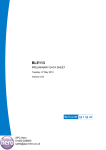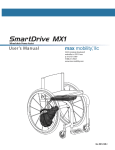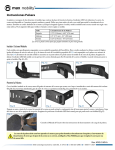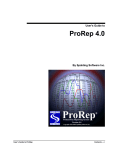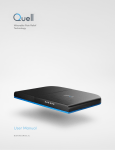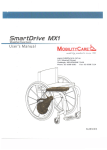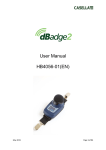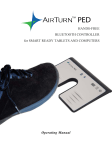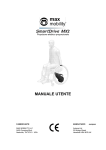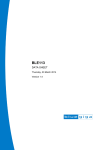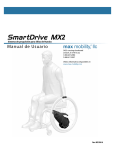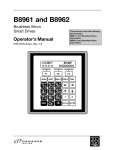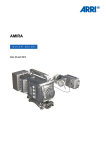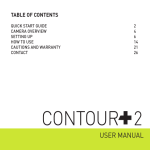Download SmartDrive MX2
Transcript
SmartDrive MX2 Wheelchair Power Assist User ’s Manual max mobility, llc ® 5425 crossings boulevard antioch, tn 37013 usa p: 800.637.2980 f: 888.411.9027 Informational videos available at www.max-mobility.com Rev. MX2 UM-A Spec Sheet SmartDrive User’s Manual I Specification Sheet ® www.max-mobility.com Manufacturer: Max Mobility, LLC SmartDrive MX2 Address: 5425 Crossings Blvd. Antioch, TN 37013 USA Wheelchair Power Assist Phone : (800) 637-2980 Range: 12.3 miles (19.8 km) Maximum speed (6o incline): 5.3 mph (8.5 km/h) Maximum speed (level surface): 5.5 mph (8.9 km/h) or 4 mph (6 km/h) for Speed Limit 2.0 ft/s2 (0.6 m/s2) Maximum acceleration: Motor power: 250 W Operating temperature: -25 oC to 50 oC Motor voltage: 36 V Continuous theoretical driving range: 14.2 miles (22.9 km) Total weight: 13.5 lbs (6.1 kg) Sound level: 60.7 dB(A) Expected lifetime / service life: Contains Bluetooth® LE: 5 years FCC ID QOQBT113 IC ID 5123A-BGTBLE113 NOTE: The stated values are from testing with a 331 lb. occupant. The range, speed, etc. vary depending on driving conditions. Drive Unit Model: MX2 Overall length: 15.3 in (389 mm) Overall height: 9.5 in (242 mm) Overall width: Omni-wheel diameter: Omni-wheel width: Weight: Contained battery type: Nominal operating voltage: Electric charge: 5.7 in (141 mm) 7.6 in (193 mm) 2.8 in (71 mm) 12.5 lbs (5.7 kg) Wristband Model: MX2 Contained battery type: Lithium-Ion (Lithium-Ion Polymer) Electric charge: 180 mA-h Nominal operating voltage: Wireless operating band: Wireless power transmission: 0 dBm to -23 dBm 36 V 3.4 A-h Wheelchair frame type: Both Rigid and Folding Folding frame attachment distance: 8.25 to 21.0 in (210 to 533 mm) User weight: 2.4 GHz (2.4000 to 2.4835 GHz) Lithium-Ion (Lithium Iron Phosphate) Wheelchair Compatibility Drive wheel diameter: 3.7 V 22, 24, 25 or 26 in (501, 540, 559 or 590 mm) 30 to 331 lbs (14 to 150 kg) The SmartDrive has been tested and conforms to all applicable requirements of ANSI/RESNA Standards for Wheelchairs - Volume 1 and Volume 2 and EN 12184. **A wheelchair’s specifications provided by its manufacturer may be slightly affected by the addition of the SmartDrive.** Rev. MX2 SS-A II max mobility ® Table of Contents 1. Introduction1 Intended Use of the SmartDrive. . . . . . . . 1 Must Read Prior-to-Use Information. . . . . . 1 Warnings and Safety Precautions . . . . . . . . 1 Electromagnetic Interference (EMI) . . . . . . . 3 Bluetooth Wireless Communication . . . . . . . 3 List of Components. . . . . . . . . . . . . . 4 2. SmartDrive Set-Up 5 Drive Unit Attachment. . . . . . . . . . . . . 5 Wristband Install and Attachment . . . . . . . 5 Thumb Throttle Buttons. . . . . . . . . . . . 5 3. Operating the SmartDrive 5 Training Mode . . . . . . . . . . . . . . . . 5 Power Assist Ready. . . . . . . . . . . . . . 5 Cruising Power Assist. . . . . . . . . . . . . 6 Deactivation . . . . . . . . . . . . . . . . . 6 Anti-Rollback. . . . . . . . . . . . . . . . . 7 Operating Conditions. . . . . . . . . . . . . 7 4. Battery8 Battery Information. . . . . . . . . . . . . . 8 Drive Unit Battery Charging . . . . . . . . . . 8 Wristband Battery Charging. . . . . . . . . . 8 Travelling and Shipping. . . . . . . . . . . . 9 5. Maintenance9 Inspection. . . . . . . . . . . . . . . . . . 9 Cleaning . . . . . . . . . . . . . . . . . . . 9 Roller Lubricating or Replacement . . . . . . . 9 Other Maintenance. . . . . . . . . . . . . . 10 6. Warranty10 Manufacturer’s Contact Information. . . . . . 10 7. EC Authorized Representative 10 SmartDrive User’s Manual 1 1. Introduction Intended Use of the SmartDrive The Max Mobility SmartDrive Wheelchair Power Assist device is exclusively intended to provide auxiliary power to manual wheelchairs to reduce the pushing power needed by their users, including pediatrics, with a user weight of 30 to 331 lbs (14 - 150 kgs). It is intended to be used by users capable of operating and maneuvering a powered and manual wheelchair, ultimately empowering them through enhanced mobility. It is also very strongly recommended that it be used on manual wheelchairs that meet the “Wheelchair Compatibility” dimensions listed in the Specification Sheet. Must Read Prior-to-Use Information Improper use of the SmartDrive or the wheelchair it is attached, depending on surface, weather, and traffic conditions, can present a potential of injury and cause damage to the wheelchair or SmartDrive. Therefore, the SmartDrive must only be handled and used under the following prerequisites: • The user is both physically and mentally capable of operating the wheelchair and device in all possible conditions and situations. • Proper instruction on its handling and operation has been received by reading and understanding this user’s manual in its entirety. • No technical modifications have been made to the device. • The user must take time to become accustom to the SmartDrive’s response and performance by first practicing its operation in a safe area that is free from hazards. One should become familiar with the push recognition, deac- tivation response, acceleration/top speed, etc. of the device before venturing out with the device, where potentially hazardous situations may exist. It is strongly recommended that the user not attempt to use the SmartDrive outdoors until it can be safely operated indoors without difficulty. If any issues or malfunctions exist, cease the use of the SmartDrive and contact Max Mobility for service/further instruction. Any contrary use to the directions of this user’s manual, to the recommendations of one’s mobility equipment dealer, or to the technical limitations defined by either Max Mobility and one’s wheelchair manufacturer is considered to be misuse of the SmartDrive. Max Mobility is not responsible for any injuries or damage caused by this type of misuse. Warnings and Safety Precautions All warnings and safety precautions issued by one’s wheelchair manufacturer must be heeded in addition to those stated in this manual. Failure to do so could result in serious injury or death. Handling or use of the SmartDrive by anyone who has not received proper instruction from this manual may result in serious injury or death. The addition of the SmartDrive to one’s wheelchair may cause it to feel different. Take the time to become accustom to this new feeling. Do not attempt to attach the SmartDrive to a wheelchair that does not meet the dimensions outlined in “Wheelchair Compatibility” section of the Specification Sheet. Always inspect your drive unit, wristband, attachment hardware and the optional thumb throttle buttons for missing parts/damage prior to each use. See the Maintenance section for parts to pay attention to. One MUST familiarize themselves with the response and performance of the SmartDrive prior to regular use. Do not attempt to use outdoors until it can be safely operated indoors without colliding into walls or any other objects. Methods for safe use of a SmartDrive attached wheelchair are different for each user depending on function and ability. The specifications provided by one’s wheelchair manufacturer may be slightly affected by the addition of the SmartDrive. Make sure both the drive unit and wristband are charged before use. Always pay close attention to the surface that you are operating your wheelchair, whether your SmartDrive is on or not, as the front casters of your wheelchair can get stuck in cracks, ruts, holes, ledges, etc. Running into these obstacles can cause you to tip out of your chair. (Continued on next page) 2 max mobility ® Do not operate over significantly rough terrain, very slick surfaces, extreme slopes, or loose ground. This may cause a loss of traction, leading to injury or damage to your SmartDrive and void the warranty. The optional buttons are designed to be used with a seat cushion as to prevent sitting directly on the cables. It is strongly recommended that a seat cushion be used on your wheelchair when using the buttons. The SmartDrive is not designed to drive up or down large curbs/steps. Only perform this maneuver when absolutely necessary and always ask for help. Also, be sure to turn off your SmartDrive wristband. The drive unit and wristband have passed industry climate testing, the same as power wheelchairs, and is considered rain/splash proof. Complete submersion of either may cause malfunction or damage and void the warranty. Use extreme caution when operating a SmartDrive attached wheelchair when near streets. Consider powering off the wristband to reduce the chance of accident or injury. Surface temperatures of the SmartDrive can increase and become hot to the touch when exposed to external sources of heat, such as sunlight. When crossing major roads, intersection, railway crossings or highways as well as when you drive steep, long slopes you should always consider having somebody accompany you in the interest of your safety. Using Anti-Tippers substantially reduces your risk of falling over backwards, which can cause serious injury. If you are afraid of tipping over, use anti-tipppers. AntiTippers will keep you from falling over, but they will limit your ability to be pulled up curbs and some other maneuvers. Just as children learn to ride bikes without training wheels, you may be able to learn to use your wheelchair with Anti-tippers. It is STRONGLY recommended that Anti-Tippers be employed to the wheelchair until the user has become accustom to operating the SmartDrive in all possible environments, situations, and conditions. With regards to driving up and down slopes, please adhere to the instructions and specifications given by the diverse wheelchair manufacturers. Riding over curbs or obstacles can cause tipping and serious bodily harm. Turn off your SmartDrive wristband when attempting to ride in these situations. If you have any doubt that you can safely cross any curb or obstacle, ALWAYS ask for help. Be aware of your riding skills and personal limitations. Develop new skills only with the help of a companion. The wristband should ONLY be worn by the user sitting in the wheelchair with the SmartDrive attached. Use caution when operating a SmartDrive attached wheelchair indoors or in confined areas. Consider powering off the wristband to reduce the chance of damage or injury. Always turn the wristband off when parked to prevent accidental activation. Always turn off your wristband before taking it off of your wrist. Always use caution when transferring in or out of the wheelchair. Every precaution should be taken to reduce the transfer distance and be certain the wheel locks are engaged to prevent the wheels from moving. Also always make sure the wristband is off when transferring to and from your chair. Do not tip or wheel your wheelchair without assistance, unless you are highly skilled. Do not shift your weight or sitting position toward the direction you are reaching as one’s wheelchair may tip over backwards or sideways. Do not lean over the top of the back upholstery to reach objects from behind as this may cause the wheelchair to tip over. Do not stand on the frame of your wheelchair. Your wheelchair is not designed for weight training and is unsafe from use as a seat while weight training. Weight training from your wheelchair substantially changes the stability of your chair and may cause tipping. Do not attempt to stop a moving wheelchair with wheel locks. Wheel locks are not brakes. Do not take a SmartDrive attached wheelchair on an escalator or moving walkway. Serious bodily injury may occur. Any modifications to the SmartDrive will void the warranty and may create a safety hazard. NOTES: Figures and diagrams of the SmartDrive in this manual may vary slightly from your device. An electronic version of this User’s Manual along with informational videos are available on our website [www.max-mobility.com] for people with visual, reading or cognitive disabilities. The Serial Number of your SmartDrive is located both on the underside of the drive unit and the bottom of the wristband. It is recommended that you save this User’s Manual and record the Serial Number below for reference. SmartDrive Serial Number: _______________________________________ SmartDrive User’s Manual 3 Electromagnetic Interference (EMI) Electromagnetic Interference comes from radio wave sources. Examples of these sources are radio/TV station transmitters, receivers, transceivers [send and receive signals], cell phones, walkie-talkies, etc. There are many sources of EMI in one’s daily environment, some that are avoidable and some that one might not even realize. Powered electronic devices, such as the SmartDrive are susceptible to EMI, both strong and weak, from these types of transmitters, as well as from electrostatic discharges (ESD) and conducted sources. These interferences can cause unintentional activation of the SmartDrive motor or damage to its control system, potentially causing a safety hazard and leading to costly repairs. Every power wheelchair or power assist device can resist EMI up to a certain level, also known as its “immunity level”. The higher the immunity level, the less the device is at risk of interference. An immunity level of 20 V/m is understood to provide sufficient protection from the sources encountered on a daily basis. The SmartDrive has been tested and found to be immune to this minimum immunity level of 20 V/m. Though equipped to be sufficiently protected against EMI, any chair modifications or accessory additions can effect its immunity. Parts from other suppliers have unknown EMI properties, and their interaction with the SmartDrive is untested. Electromagnetic energy becomes increasing more intense the closer to the source you become. Therefore, it is recommended that the SmartDrive not be operated in close vicinity to sources of radio waves. There are three categories that EMI sources fall under: 1. Long Range Transceivers: These are sources of strong radio waves, including commercial radio and TV broadcast antenna towers and amateur (HAM) radios. 2. Medium Range Mobile Transceivers: These are sources of potentially strong radio waves, including two-way radios used by emergency vehicles, tractor-trailers, and taxis. 3. Handheld Transceivers: These are sources of relatively low strength waves but have the possibility of getting very close to your wheelchair, including walkie-talkies, citizen band (CB) radios, cell phones, and other personal communication devices. The following are not likely to cause EMI problems: Cordless phones, MP3/CD players, TV sets, and AM/FM radios. Do not operate hand-held transceivers (transmitters-receivers), such as citizens band (CB) radios, or turn ON personal communication devices, such as cellular phones, while the device is ON. Be aware of nearby transmitters, such as radio or TV stations, and try to avoid coming close to them. If unintended movement occurs, turn the device OFF as soon as it is safe. Be aware that adding accessories or components to your wheelchair may make it more susceptible to EMI [Note: There is not easy way to evaluate their effect on the overall immunity of the device]. Report all incidents of unintended movement to Max Mobility, and note whether there is a source of EMI nearby. USA / Canada This device complies with Part 15 of the FCC rules. Operation is subject to the following two conditions: (1) This device may not cause harmful interference, and (2) this device must accept any interference, including interference that may cause undesired operation. Any changes or modifications not expressly approved by the party responsible for compliance could void the user’s authority to operate the equipment. Bluetooth® Wireless Communication Bluetooth® wireless communication [2.4 GHz frequency band] is used by the wristband to tell the drive unit when to deactivate the power assist, as well as to help verify that a push has been performed prior to power assist activation. The wristband must be within 25 ft (8 meters) for the two components to connect and communicate. The maximum output power of this technology is 10 mW, and the operation of this device in close proximity to other wireless devices [i.e. electromagnetic security systems, cellular telephones, Bluetooth® headsets] could cause the device to lose connection. Power assist is always deactivated whenever the motor is driving and there is a loss of connection; the drive unit will beep and wristband will vibrate as indication when this happens. Worst case coexistence testing was performed on the device to ensure its safety and effectiveness. Please contact Max Mobility immediately for troubleshooting if continuous connection issues are experienced with the device. max mobility ® 4 List of Components 1. Thumb Throttle Buttons [sold separately as optional accessory] 2. Attachment Hardware 3. Drive Unit 4. Rollers 1 5. Drive Unit Handle 6. Drive Unit LEDs 7. Drive Unit Toggle Switch 8. Drive Unit Charger Cover 9. Charger / Button Receptacle 10. Omni-Drive Wheel 11. Charger / Button Connector 12. Button LED 13. Button Velcro Loop 14. Wrist Band 15. Wristband LED 16. Wristband Button 17. Wristband USB Charging Port 12 13 1 3 2 14 17 11 16 15 5 7 6 8 9 10 4 SmartDrive User’s Manual 5 2. SmartDrive Set-Up Drive Unit Attachment The SmartDrive is designed to easily and quickly attach to all types of manual wheelchairs, both rigid and folding. Refer to the Specification Sheet to verify the compatibility of the wheelchair. Use the separate directions provided with your drive unit attachment hardware for correct set-up prior to use. Adjustments made to the wheelchair set-up could affect the orientation of the SmartDrive. Adjust the attachment hardware, if needed, whenever changes are made to the chair or its wheels. Wristband Install and Attachment The wristband module is designed to be easily installed into the wrist band of size that securely holds it to the top part of your wrist. It has an embedded accelerometer that verifies that your hands are pushing on your handrims before activating the power assist, and also senses when you tap your hand against the handrim to deactivate the power assist. Additionally, it is equipped with an LED and vibration motor to indicate different states and activations/deactivations that occur during operation. Each new SmartDrive drive unit is shipped with a wristband module that is specifically paired to it to prevent communication with other drive units. This is indicated by the same last four (4) digits in the serial number on each [i.e. drive unit serial number 201234 is paired with wristband module serial number A21234]. Use the separate directions provided with your wristband for module installation and attachment instructions. Thumb Throttle Buttons [sold separately] The two (2) SmartDrive frame mounted thumb throttle buttons are easily mounted to a wheelchair to allow for close access and easy pressing. The buttons can be used to deactivate the motor, as well as provide a means of actively powering the motor. These are sold separately as an optional accessory. Use the separate directions provided with the buttons for correct set-up and operation prior to use. 3. Operating the SmartDrive Training Mode SmartDrives are shipped in training mode to allow for familiarity and wristband deactivation practice prior to extensive use. Training mode is indicated by green [and red] LED indication on the wristband [instead of blue and red for normal operation as described in the following section]. In this mode, the deactivation means is the same as normal operation [see Deactivation section], but you are also able to deactivate the power assist by braking on the handrims of the wheelchair. The SmartDrive recognizes the deceleration that the wheelchair experiences from the braking and turns the motor off. This mode should be used to perfect the tapping motion needed by the wristband to deactivate the motor, upon which it is time to switch to normal operation to get the most our of your SmartDrive in all the environments encountered on a daily basis. To get out of training mode, just press and hold the button on the wristband for five (5) seconds, at which point you will feel a vibration and see the wristband LED change to blue; then release the button. You are now in normal operation and can only deactivate the power assist with the wristband/tapping. Power Assist Ready The user of a SmartDrive equipped wheelchair is able to use the power assist whenever desired or turn the device off and operate their wheelchair as if the SmartDrive was not on their chair. With the drive unit already attached to the wheelchair and powered on [as described in the attachment hardware directions], the SmartDrive will wait for the specifically paired wristband to be powered on. The wristband is turned on by pressing and releasing the button on its top side. Once the wristband is turned on [as indicated by the LED on the wristband giving a blue flash every (1.5) seconds and a single vibration] it will attempt to wirelessly connect to the drive unit. Whenever the wristband is attempting to wirelessly connect to the drive unit, whether because of a loss of connection or from initially turning the wristband on, the LED on the wristband will flash red. When the wireless connection is made or regained, the red flashing will stop. Once the wristband has wirelessly connected to the drive unit, the SmartDrive power assist is ready and waiting for a push to be performed to provide assistive power. 6 max mobility ® Pressing and releasing the button on the top of the wristband will turn it off. If the wristband has been turned off, the indication LED will cease from flashing and a double vibration will be given. With the wristband off, the drive unit will not be able to activated to provide power assist, so you are able to push the wheelchair around with no power assist. Cruising Power Assist With the power assist ready [the drive unit and wristband both on and wirelessly connected], the SmartDrive is able to recognize when you have performed a push on the wheelchair. In turn, the device activates the omni-drive wheel, and an assistive drive power is provided, propelling you at a speed equal to that which was attained by the push. The SmartDrive is able to recognize each individual’s push, so no alterations to one’s propulsion technique is needed. This is ideal for everyday use as it reduces the number of pushes that have to be performed. Push recognition and motor activation is indicated to the user by a vibration in the wristband and the LED being illuminated solid blue. The SmartDrive is designed to continue to drive the user until a tapping motion is performed by the wristband worn arm or the wristband is turned off [as described in the Power Assist Ready section] OR until another, faster push is performed. In this last case, the SmartDrive will speed up and begin to drive the user at this faster speed attained when the user pushed harder [a single vibration will be given while the LED on the wristband will continue to stay lit blue]. Once a push is performed and the motor is activated, position your hands over your handrims [and thumb throttle buttons, if present] to be prepared to turn off the motor when braking/deactivated power is desired. Refer to the Specification Sheet for the maximum speed that the SmartDrive is able to drive from push activation. If any malfunctions or push detection/deactivation/thumb throttle button issues are experienced with the SmartDrive, cease use of the device and contact Max Mobility for immediate assistance. The SmartDrive is able to recognize all types of pushes. Do not alter the way that you push for this could lead to injuries in the future. Care should be taken when using the SmartDrive on a decline. Consider switching the wristband off when descending down a slope. The acceleration of the SmartDrive could possibly cause the wheelchair to tip-over backwards, causing injury. It is recommended that the user lean slightly forward to prevent this tipping. Deactivation As mentioned in the prior section, there are multiple ways to deactivate the power assist. The safest and therefore preferred way of deactivation is to perform a hitting motion with your wristband wearing arm. Motion sensors in the wristband sense this hitting motion [see graphics below] and then deactivate the motor. Ideally, the deactivation motion will be performed by the user hitting their hand against their handrims with a stiff wrist prior to braking. Sufficient deactivation motion is indicated by the LED on the wristband illuminating red for one (1) second. This indication is given even when the motor is not driving, so practice and familiarity should be done prior to use. Whenever the motor is deactivated, the wristband will vibrate in addition to its LED being illuminated red as indication that power assist is no longer being provided. The final way to deactivate the motor is to press and release the button on the wristband. This means of deactivation will give a double vibration and red LED indication before the wristband turns off. If any malfunctions or push detection/braking/thumb throttle button issues are experienced with the SmartDrive, cease use of the device and contact Max Mobility for assistance. SmartDrive User’s Manual 7 The push activated power assist can ALWAYS be deactivated by pressing the wristband button to turn it off. If you have thumb throttle buttons, pressing and releasing either button will also deactivate the motor if driving. Serious care should always be taken on hills, inclines, ramps, etc. While the wristband is designed to sense the tap/impact of your wristband wearing hand, other movements done with your hands while the motor is driving can possibly cause deactivation. Whenever power assist is being provided, it is recommended to position your hands over your handrims for steering, then a stiff wrist tap then brake when desired to deactivate and slow down. ALWAYS turn your wristband off before transferring out of your wheelchair and taking the drive unit off to prevent accidental activation. Anti-Rollback Anytime that the power assist is deactivate on an incline or due to a loss of wireless connection [the drive unit will beep for this second case], automatic rollback resistance lasting (3) seconds will be provided to prevent the wheelchair and the user from rolling backwards. Whenever the rollback resistance is not activated, the SmartDrive will roll backwards freely. As warned before, serious care should be taken on all hills, inclines, ramps, etc. The rollback resistance may not be able to prevent the quick rolling back on especially steep slopes and/or for very heavy wheelchair users. Anti-rollback is not a parking brake. Be sure the secure your wheelchair with brakes if stopping on a slope is desired. Operating Conditions The SmartDrive is designed for typical operating conditions encountered by a manual wheelchair user on a daily basis. Max Mobility recommends restricting the use of this device to indoor and light outdoor use. All operating conditions set forth by one’s wheelchair manufacturer should always be heeded, in addition to the avoidance of the following: • • • Loose dirt, sand or gravel Standing water Icy surfaces • • Rough terrain Extreme slopes The total weight of the SmartDrive assembly is 13.5 lbs (6.1 kg). This weight should be included in calculating the on-board weight of the wheelchair. The maximum allowable on-board weight outlined by one’s wheelchair manufacturer should never be exceeded with the addition of the SmartDrive. The best way to climb ramps and inclines is to go slow. On cross-slopes, perform a push to get the motor driving, then brake with the uphill hand on the wheelchair handrim to go straight. Also, rollers on the omni-drive wheel allow for pivoting of the wheelchair as they smoothly roll side-ways over surfaces. Care should be taken to make sure the drive unit doesn’t get caught on things like curbs or small sidewalk cracks when you pivot. The attachment hardware is designed to fail first, so if you the drive unit stuck, this can break the clamp/folding adaptor bar and leave you without power assist. Sometimes it is best to turn the SmartDrive off, negotiate the situation manually and then start using the assistive power again. If any part of the SmartDrive is accidentally submerged or doused in water, the user should cease usage and allow 12 hours for it to air dry before attempting to use again. It is recommended to always store the drive unit and wristband indoors. If your device has been stored in extreme temperatures, allow time for it to warm up or cool down prior to use. The operating temperature of the SmartDrive is between -25 oC and 50 oC If any malfunctions or issues are experienced with the SmartDrive, cease use of the device and contact Max Mobility for assistance. 8 max mobility ® 4.Batteries Although the battery in the SmartDrive drive unit is very small and compact, it can store a large amount of power. Faulty handling or storage can damage the equipment, and in some cases result in shocking, burns, or fire. Battery Information The drive unit houses the rechargeable Lithium Iron Phosphate battery used to power the SmartDrive motor. The newest in Lithium-Ion technology, these batteries offer a significantly longer cycle life and faster charging rate than standard lithium ion cells. The blue LEDs on top of the drive unit are used to indicate the battery charge level. All four (4) LEDs being illuminated indicate a full battery. As the charge of the battery decreases, so does the number of LEDs being lit. The drive unit will give a beep whenever the battery is below 20% and the power assist is activated to let you know charging of the battery should be done as soon as possible to avoid running completely out. Low wristband battery is indicated by the LED on the wristband flashing blue then red every (1.5) seconds when on. Again, charging of this battery should be done as soon as possible to avoid running completely out. It is encouraged to charge each battery every night to avoid running out of charge during daily use. The life of the battery will not be deteriorated by charging when it is partially drained. Make sure the charging receptacles are completely dry and free from debris [as the magnets can attract some] before plugging in the charger, for this can cause a spark or short. Blow water out of the receptacle if you suspect there being water in it. It is also recommended to always cover the button/charger receptacle whenever either are not plugged into the drive unit. Long-term storage of the batteries [more than 3 months] reduces its capacity through spontaneous discharge. Charge the battery to at least 30% before you store it long-term, and avoid storing the unit where the temperature is too high or with high humidity. Drive Unit Battery Charging Only use the provided charger to recharge the drive unit of the SmartDrive. Other chargers may damage your unit, or cause a fire. Also, always power off and never attempt to use the drive unit while charging. The battery charger is to be used indoors and in dry locations. Use an easily accessible outlet that is close to drive unit that is to be charged. Do not use or attempt to repair a damaged/defective charger. Contact Max Mobility if a charger is damaged and do not dispose of in your household garbage. The charging transformer box is intended to be laid flat during charging. Only use the power supply cord provided with the charger. The charger is capable of operating at different voltages without adjustment. To charge the drive unit, plug the battery charger cable into a wall outlet, at which point the green LED on the charger box will illuminate. Connect the magnetic charger connector to the powered off drive unit magnetic receptacle [moving the rubber plug to the side]. The magnets in the connectors will only allow the plug to connect in one direction. Once the unit is connected and charging, the LED on the charger will turn red. When the LED on the charger turns back to green, the drive unit is fully charged. Remove the connector from the drive unit and replace the rubber cap to protect the receptacle on the drive unit. The estimated charge time for a full recharge of the drive unit battery is approximately 3 hours. Wristband Battery Charging Plug the provided wall adapter into a wall outlet and plug the USB cable [standard USB type A] plug into the wall adapter [this can also be done prior to plugging into the wall]. Then plug the USB connector [standard USB type micro-B] into the small port on the side of the wristband module making sure the it is powered off. The LED indicator light on the wristband will be red while the unit is charging, and will turn green once the battery is fully charged. The wristband can be charged using any standard USB [type A] port found on a computer, car charger with USB plug, etc. and any type A to micro-B cable. The estimated charge time for a full recharge of the wristband battery is approximately 2.5 hours. SmartDrive User’s Manual 9 Always store and charge the drive unit and wristband in a cool, dry area. Hot and damp environments can damage or short the unit, requiring a costly replacement. Make sure the charging receptacles are completely dry before plugging in the charger, for this can cause a spark or short. Also, always power off and never attempt to use the wristband while charging. Do not throw away the drive unit or wristband. Please properly dispose of each by recycling at the end of its life or send it back to Max Mobility. Travelling and Shipping Because the SmartDrive drive unit houses a Lithium-Ion battery, special considerations have to be taken when travelling on an airplane. The SmartDrive must be carried onto your plane and should be stored in the overhead bin. It is recommended that advanced arrangements be made with each airline operator and approval received prior to departure date. A “SmartDrive Airline Passenger Certificate” can be downloaded from the Max Mobility website [www.max-mobility] or provided upon request. Use the provided foam stand for the drive unit to prevent movement and damage when transporting in a car. If riding in a cab, it is recommended to have the driver hand you the drive unit so that it doesn’t get damaged from movement when placed in the trunk. Also, special considerations need to be taken when shipping the SmartDrive due to the battery. Contact the shipping company being used for instructions on how to correctly package and label prior to shipping. Be sure to provide plenty of padding/ protection for the drive unit to prevent damage. 5.Maintenance Inspection Always inspect the drive unit, omni-drive wheel, wristband, attachment hardware and thumb throttle buttons for missing parts/damage prior to each use. Cease use and contact Max Mobility or your mobility equipment dealer if you notice any of the following: • • • • • • • • • Broken or cracked plastic Any of the rollers do not spin with little resistance, have flats worn in them or any other significant damage Significantly worn down rollers and/or damaged wheel plastic Ripping rubber on the wristband Missing or loose screws Adaptive clamp has rotated downward [on rigid wheelchairs] Broken or fraying cables Magnetic receptacle or plug has collected metal shards Any abnormal motor activation/deactivation activity [during use] Cleaning Cleaning of the SmartDrive can be done by wiping all of the parts down with a damp wash rag. This should be done at least once a month, or as needed. Roller Lubricating or Replacement The omni-drive wheel contains 16 rubber rollers that may wear down, depending on driving conditions, after extensive use. These rollers are able to be replaced. Also, in snowy climates, salt may cause corrosion to the bearings on these rollers and affect their performance. Spraying lubrication on these bearings will increase their usable lives (see graphic to the right). Contact your mobility equipment dealer or Max Mobility for information on replacing/maintaining the rollers on your SmartDrive unit. max mobility ® 10 Other Maintenance Contact Max Mobility or your mobility equipment dealer for any other maintenance or replacement that the device might need. Troubleshooting Safeguards are designed to prevent damage to the drive unit circuit board and battery from other part failures or atypical situations. Here is a list of these safeguards, how they are indicated and how to address them: • • • Two (2) blinking drive unit LEDs indicate a bad motor. The motor will have to be replaced before it is operable again. Three (3) blinking drive unit LEDs indicate a current spike. The drive unit will need to be turned off and then on to use again. Four (4) blinking drive unit LEDs indicate overheating inside the unit. Turn the drive unit off and let it cool before using again. Contact Max Mobility or your mobility equipment dealer for any other issues that you experience with the device. 6.Warranty Max Mobility offers a 2 year warranty against manufacturing defects. Max Mobility’s obligation under this warranty shall be limited to repairing or providing replacement of part(s), which are found to be defective. Any part(s) of the system replaced by us at our discretion shall be with a functionally operative part. This warranty may be voided if: 1) the product is not used according to instructions given in this instruction manual, 2) defects were caused by improper use as determined by the company personnel, 3) modification or alteration of any nature is made in the electrical circuitry or physical construction, or 4) defects are due to cause beyond control like lightning, abnormal voltage or while in transit at the purchaser’s place of business. Max Mobility is not responsible for any damage to one’s wheelchair caused by the attachment or operation of the SmartDrive. An extended warranty for the SmartDrive may be purchased. Contact Max Mobility if you are interested in extending your warranty. Manufacturer’s Contact Information Manufacturer: Max Mobility, LLC Address: 5425 Crossings Blvd. Antioch, TN 37013 USA Phone: Fax: Website: Email: (800) 637-2980 (888) 411-9027 www.max-mobility.com [email protected] 7. European Commission (EC) Authorized Representative Advena Ltd. Pure Offices Plato Close Warwick CV34 6WE United Kingdom MUST be completed and returned...failure to comply will restrict future orders. 5425 crossings boulevard, nashville, tn 37013 usa • p: 800.637.2980 • f: 888.411.9027 • www.max-mobility.com SmartDrive MX2 Training Certification It is important for your safety and the safety of those around you that you are properly trained to use the SmartDrive. Please take this training seriously and be sure to fill-in all information. If you do not understand something, just ask. SmartDrives are shipped in training mode to allow for familiarity and wristband deactivation practice prior to extensive use. Training mode is indicated by green LED indication on the wristband. There are instructional videos available at www.max-mobility.com that are very helpful in learning all about your SmartDrive [use the Closed-Captions for subtitles in other languages]. 1) Read the SmartDrive User’s Manual. Please heed all of the warnings in yellow, as this information is important for your safety. Pay close attention to situations where it is safest to turn the SmartDrive OFF. 2) Demonstrate each of the skills to your dealer and check them off once you are confident with each skill: Install the wristband onto your wrist. Understanding that the wristband should be OFF whenever handling the drive unit [or transfering into / out of your chair], turn the drive unit on and install it onto your wheelchair. Turn the wristband on and allow for it to wirelessly connect to the drive unit. Before pushing, practice tapping your hand against your handrims with a stiff wrist. You will see the wristband LED go red if it’s a good tap. Continue to practice this tap until you get it every time. Push slow to go and tap then brake to stop. Push slow to go slow, then push faster to go fast, and then tap brake to stop. Once you have perfected the tapping motion needed by the wristband to deactivate the motor, it’s time to switch to normal operation to get the most our of your SmartDrive in all the environments encountered on a daily basis. To do this, just press and hold the button on the wristband for five (5) seconds, at which point you will feel a vibration and see the wristband LED change to blue; then release the button. While in normal operation - push to go, turn in a figure 8, and then tap brake stop. 3) Sign this form below, scan and e-mail it to [email protected] or fax it to (888) 411-9027. SmartDrive Serial Number: _______________________________________ Date: ___________________ Client I certify that I have read the User’s Manual and demonstrated the skills checked above. I accept that the SmartDrive can be dangerous if not used carefully and I take responsibility for making responsible driving choices while using it. I understand there are many situations where the SmartDrive should be turned OFF to prevent it from unintentionally powering forward, including: downhill slopes, up or down curbs, climbing large sidewalk cracks, while in confined spaces, before handling the drive unit and transferring into and out of my wheelchair. Name: _____________________________________ Signature: _____________________________________ Dealer I have observed the client performing the skills checked above. Name: _____________________________________ Signature: _____________________________________ CUT OR TEAR HERE IF NEEDED

















